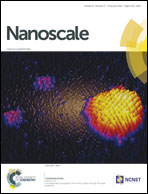Transmetallation as an effective strategy for the preparation of bimetallic CoPd and CuPd nanoparticles
Abstract
The preparation of palladium alloy nanoparticles is of great interest for many applications, especially in catalysis. Starting from presynthesized nanoparticles of a less noble metal, a transmetallation reaction involving a redox process at the nanoparticle surface can be exploited to modify the nanoparticle composition and crystalline phase. As an example, monodispersed ε-cobalt and face-centered cubic copper nanoparticles were synthesized in organic solvents at high temperature and the as-formed nanoparticles were reacted with palladium(II) hexafluoroacetylacetonate resulting in the formation of alloyed nanoparticles whose composition closely follows the reactant ratio. The oxidative state of the nanoparticle surface greatly affects the success of the transmetallation reaction and a reduction treatment was necessary to achieve the desired final product. Electron microscopy and X-ray diffraction showed that for cobalt a limiting palladium content for the ε-phase alloy is found, above which an fcc alloy nucleates, while for copper the fcc crystalline phase is preserved throughout the whole composition range.


 Please wait while we load your content...
Please wait while we load your content...